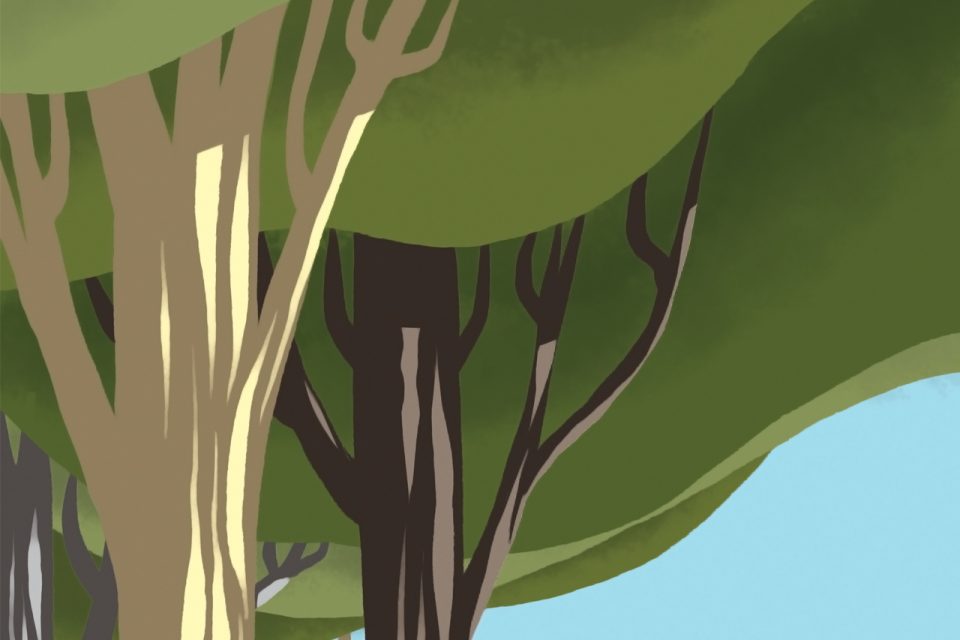Trees of (college) life
At the southwest corner of Stevenson Hall stands a tree that should not be there.
In the spring, its pink and white flowers provide a welcome visual accent to a campus landscape painted in red brick, gray sidewalk, and abundant green grass. Though its ancestor trees came from half a world away, Prunus serrulate thrives right here in the middle of corn country.
Appears In Illinois State: Spring 2025 FirstWord: Spring 2025 University News briefs: State Farm commits $3 million to data science Where are they now?: Dave Bentlin Kids learn to love hoops on Education Day Then and Now: Nursing education Pause for Applause: Spring 2025 A Day in the Life: Students connect through Fraternity and Sorority Life Earned it: Fischer ‘humbled’ by alumni award Class notes: Spring 2025 In memory: Spring 2025 Redbird trivia: Spring 2025 Thanks to you: Bone Scholar strives to make a difference Redbird Legacy: Music runs in the Mack family Where are they now?: Tammy Kocher ’93 The lessons of Bangladesh: Dr. Ali Riaz gives voice to his native country as it fights for democracy Athletics briefs: Beggs named director of Athletics Appetite for success: Entrepreneur builds community through food Behind the lens: New York Times photographer Todd Heisler ’94 captures history in the making Read AllThis Japanese cherry, as it’s commonly known, is the only of its kind at Illinois State. It’s part of a vast and diverse inventory of trees and plants scattered across the University’s main campus that became known as the Fell Arboretum in 1995 when it was granted arboretum status by the International Society of Arboriculture, though a universitywide passion for trees and plants took root much earlier thanks to the vision of the University’s founding father.
Campus trees spruce up the space and welcome visitors to campus, but they serve an even greater purpose than that.
“A lot of people think beautification is our top priority, and that is one of them. We love having students and people from the community out here enjoying the beautiful trees,” said Sydney Metternich, M.S. ’22, coordinator of Fell Arboretum outreach and botany instruction. “But our primary mission is to plant and maintain different species so that students training to become botanists and biologists and horticulturalists can come out here and learn about them, see them, touch them. It’s a living library.”
Campus trees have provided shade for generations of Redbirds. It’s believed some trees blooming on campus right now are as old as the University itself.
“The Fell Arboretum holds a special place in our hearts, not only as a vibrant learning library but as a peaceful retreat for our students, faculty, staff, and community,” said Kristie Toohill ’97, M.S. ’16, executive director of Facilities Services. “We honor its legacy by ensuring its impact for generations to come.”
History lesson
A renaissance man in every way, Jesse Fell founded Illinois State University, the Town of Normal and several surrounding Central Illinois communities, and the newspaper that became The Pantagraph. Fell was an educator, lawyer, and businessman whose interests and ventures often intersected with one another.
Such was the case at Illinois State University, where the famously avid arborist envisioned an environment for learning filled with trees and plants. Fell built support for his vision and led a lobbying effort in 1867 that resulted in a $3,000 state appropriation for landscaping the campus. Noted landscape architect William Saunders was commissioned for the work, at a fee of $65, and in the spring of the following year, he and Fell coordinated the planting of 1,740 trees. Fell planted many himself, using a modified horse-drawn wagon.
Fell desired a campus with every plant and tree native to Illinois present, so that they may be studied and enjoyed. Fell’s ambition lives on today in the arboretum that bears his name.
Performing tree surgery
Joe Caslow grew up with a love of the natural world. The son of a high school biology teacher has forged a career that keeps him working outdoors. Caslow has been employed by a wildlife foundation managing invasive species and worked for commercial tree services.
It all led him to Illinois State, where he has one of the more unique job titles on campus: tree surgeon. “I’ve always loved trees,” he said during a break between trimming oaks outside Fell Hall. “The bigger the better.”
Caslow tends to the overall health of Illinois State’s trees. He spends his days planting, pruning, and, when necessary, felling campus trees. He’s well suited for the role as a certified arborist and tree safety professional. Caslow is an expert in the physics of safely felling big trees with elaborate rigging systems. Last year when surveying storm damage, he noted the “color was off” on an iconic Austrian pine. A master arborist was called in, and it was decided the tree had to come down.
“I hated that because I had never seen one so big,” Caslow said. “We found a picture of it in an old yearbook from 1907, so it was probably about 130 years old. In this area, they’re not supposed to live past 60 or 70 years.”
The arboretum staff tries to plant a new tree for each one felled and, on an unseasonably warm December day, Caslow motioned toward the center of the Quad where a young white oak sapling grew.
“That’s the first one I picked out and planted,” Caslow said, proudly. “When it’s hot and dry in the summer, I’ll take the water truck out for the younger trees, and I’ll give that one an extra drink. That’s my baby.”
A bountiful feast … for humans?
Why are there so many squirrels on the Quad? It’s because the fruits of Illinois State’s trees provide a healthy diet for the wildlife that call it home.
But could a hungry human subsist on a harvest from Illinois State’s trees and bushes? Sure. Is it advised? Probably not.
“We wouldn’t encourage it,” Metternich said with a laugh. “Generally, foraging is good if you have a breadth of knowledge that would allow you to discern between plants, but I’m afraid that’s probably not the case for everybody.”
Metternich once filled a bucket with freshly dropped pecans to take home from work. She tried again a year later, “but the squirrels had already taken off with them.”
Pecans are one of the best and easiest foods to forage; others include butternuts, hazelnuts, and walnuts. Fruits of the mulberry, beech, black chokeberry, and serviceberry are also edible. Maple trees could be tapped for syrup. The fruit of the crabapple tree is too bitter to eat raw but can be made into a jelly.
And a beverage to wash it down? Teas can be made from the flowers of saucer magnolia and linden trees, birch bark, or pine and fir needles. Dried root bark from the sassafras tree could be used to make a drink similar to root beer or sarsaparilla.
“The Fell Arboretum holds a special place in our hearts, not only as a vibrant learning library but as a peaceful retreat for our students, faculty, staff, and community.”
—Kristie Toohill ’97, M.S. ’16
Family tree
Whenever Lee Davis ’65, M.S. ’69, wants a reminder of his time at Illinois State, all he needs is a trip into the backyard of his York, Pennsylvania, home.
Newly married in 1979, Davis returned to Normal to show his new wife his college home. He told her how he’d learned of ancient plant species from his botany professor, Dr. Lewis Martins, and among the campus landmarks he pointed out on the tour was the famous ginkgo tree in front of Cook Hall. He told his wife of the odorous seeds the tree dropped every fall.
“We were even able to find a few of them as we searched the bushes nearby,” Davis recalled. “I brought a dozen or so seeds home, germinated a few, and planted one, which has since grown into a mature female tree.”
The descendent of the Cook Hall ginkgo some 700 miles east of Illinois State’s campus now rivals its mother tree. It, too, drops seeds every fall. “I enjoy telling visitors about its mother tree at Illinois State University and have given away many ‘grandson’ and ‘granddaughter’ seeds to people who want one in their yard,” said Davis, noting a Penn State University arborist was among the most recent recipients.
Davis is proud to have a unique, living souvenir of his time on campus. “Every day, I look out my window and think of my ISU days,” he said.
Diversity matters
Illinois State currently boasts 2,982 trees from 288 unique botanic taxa. More than 100 of those trees represent the only of their kind on university property. Nine are considered endangered by the International Union for Conservation of Nature.
By the numbers
2,982 trees in the Fell Arboretum
343 trees from the Sapindaceae family, the most common on campus (includes maples, horse chestnuts, and buckeyes)
288 unique types (botanic taxa) of trees in the arboretum
152 crabapples on campus, the arboretum’s most common tree
110 unique trees in the arboretum that represent the only of their taxa
9 taxa present in the arboretum conside
Each tree and plant possesses its own strengths and weaknesses. Too much or not enough water or sunlight, or exposure to extreme temperatures, can negatively impact them. Some are prone to species-specific threats caused by fungi, such as Dutch elm disease, or insects, like the emerald ash borer.
“That’s why you want a varied population of trees, so if a disease does make its way here, it gets slowed down,” Caslow said. “Then it can’t just jump from tree to tree.”
Diversity gives the campus landscape an aesthetically pleasing mix of textures and colors as the seasons change, but it also benefits the overall health of the arboretum. Illinois State has lost trees to disease, but the arboretum has avoided catastrophic damage thanks to its diverse makeup.
“Jesse Fell wanted this diversity,” Metternich said. “It’s helped the arboretum over time, and why we have such old trees is because that’s been the theme from the start.”
Linked trees
Illinois State’s “living library” doesn’t use the Dewey Decimal System or have a card catalog. Its inventory is maintained in the 21st century with ArcGIS.
A geographic information software (GIS) platform, ArcGIS offers front-end users an interactive map of Illinois State’s campus trees with ID numbers, common and scientific names, and photos. Back-end users—Facilities and arboretum staff—can enter updates on tree health and care plans.
In-person tours of the arboretum are routinely provided, but a digital tour is also available on the Alumni Association’s official YouTube channel, offering tree enthusiasts an opportunity to visit the space in cyberspace.
A fitting tree-bute
One way to “Create Your Legacy”—or recognize someone else’s—is through Illinois State’s tribute tree program. The program supports the introduction of new trees and woody plants into the arboretum’s collection, while also honoring individuals with a special connection to the University.
Donor trees are tagged with information about the tree and the honored individual’s name. For a donation of $1,500, interested donors can work with Facilities Services staff to select the type of tree and determine its placement location. “The money donated to honor the individual helps support our groundskeepers in caring for the tree over time, and it contributes to the overall work of the Fell Arboretum,” said Metternich. “It’s a great way to support the arboretum.”
Bringing people together
From Jesse Fell to former stewards Chuck Scott and Don “the Dean of Green” Schmidt to the current staff caring for the arboretum, Illinois State’s trees and plants have brought people together for a common cause for generations.
That work continues today with Illinois State’s Tree Advisory Committee. The group composed of faculty, staff, and community members brings varied expertise to guide the arboretum in implementing its campus tree care plan, maintaining Illinois State’s Tree Campus Higher Education status and ArbNet accreditation, and planning Arbor Day events.
A communitywide dedication to trees has also recently led to the formation of the Bloomington-Normal Arbor Day Affiliates (BNADA), where knowledge and expertise is shared between tree lovers from Illinois State, Heartland Community College, Town of Normal, City of Bloomington, and Westminster Village.
Together, BNADA members have planted trees in the community, and organized tree talks and tours, including a ginkgo tour of Bloomington-Normal.

Arboreal idol
Everyone has their favorite, so let’s put it to a vote! Cast your vote for one of these eight iconic trees—or submit a write-in candidate—to determine the Arboreal Idol!
European Beech (Fagus sylvatica)
This tree has it all: a perfectly rounded crown, attractive wavy-edged leaves, and smooth gray bark. It’s easily identified by its low hanging branches. But please, no climbing!
Sassafras (Sassafras albidum)
This tree has it all: a perfectly rounded crown, attractive wavy-edged leaves, and smooth gray bark. It’s easily identified by its low hanging branches. But please, no climbing!
Scots pines (Pinus sylvestris)
These trees native to Eurasia are disappearing from Illinois due to disease and a changing climate, but two arched Scots pines form a living gateway to the north entrance of the Quad. Welcome!
Sycamore (Platanus occidentalis)
You can’t miss the behemoth on the Quad side of Fell Hall. Lovers of plus-sized trees prize this one with the widest trunk diameter of any campus tree. (Hey, it’s just big-boned!)
Ginkgo (Ginkgo biloba)
The giant outside Cook Hall is loved despite its “Stinko” nickname. It drops a fluffy, golden carpet of leaves every fall, but it’s mostly known for its smelly seeds. Thanks, butyric acid…
Saucer magnolia (Magnolia denudata)
One of the arboretum’s largest magnolias is prominently placed in the center of the Quad, and it draws a crowd when its pink flowers bloom early in the spring. It’s a welcome sign when we’ve all had enough of winter.
Sugar maple (Acer saccharum)
One of many maple varieties present on campus, it’s a fall foliage fan favorite thanks to its bouquet of pretty yellows and reds. Homecoming is a perfect time to check it out.
White oak (Quercus alba)
We wouldn’t forget the state tree! The Fell Arboretum is home to some as old as the University itself. These trees share in Illinois State’s value of sustainability as they sequester high volumes of carbon.
Latest Publications
- A message to the campus community on faculty negotiations, April 3, 2025The Provost thanks the University’s and Union’s negotiating teams for their continued good faith efforts during this week's ongoing faculty negotiations, referring to it as an indication of the deep care each group has for the broader good at Illinois State.
- Milner Library announces applications for its next Circus and Allied Arts fellowshipMilner Library will award fellowship(s) of $1,500.00 to selected scholars interested in researching any topic that requires the onsite use of the Circus & Allied Arts Collection at Illinois State University.
- UFISU contract negotiations update, April 3, 2025The University and the Union met for this forty-sixth negotiation session. The University presented a significantly enhanced on-the-record economic proposal, as well as an on-the record proposal on Definitions.
- RISE Town Hall forums, April 22 and 23Illinois State University is hosting RISE Town Hall open forums on Tuesday, April 22, and Wednesday, April 23, to provide an opportunity for the campus community to learn more about the redesign project and the guiding principles governing the redesign.
- FirstWord: Spring 2025A message from University Marketing and Communications Executive Director Brian Beam, M.S. ’94, MBA ’10
- University News briefs: State Farm commits $3 million to data scienceIllinois State received a $3 million gift commitment from State Farm to support the University’s new interdisciplinary data science bachelor’s degree program.
























